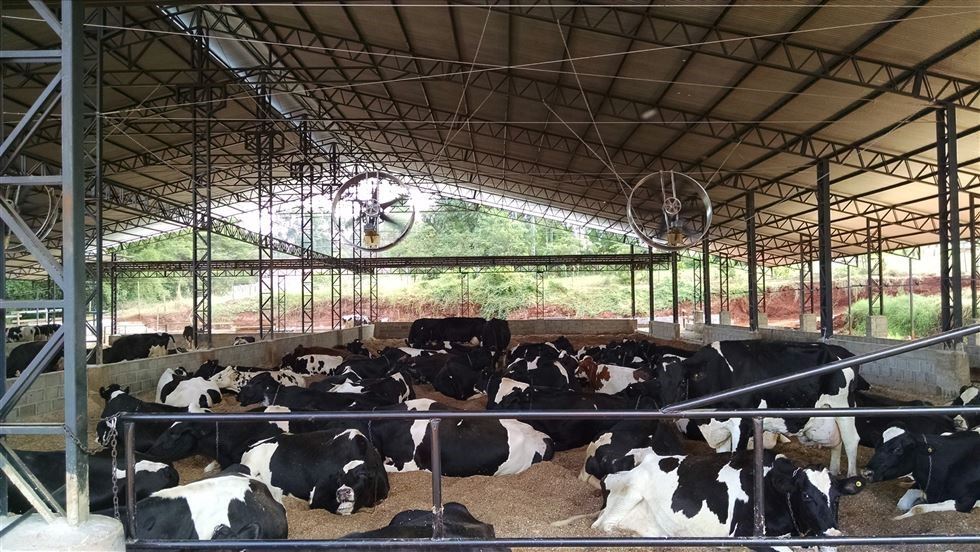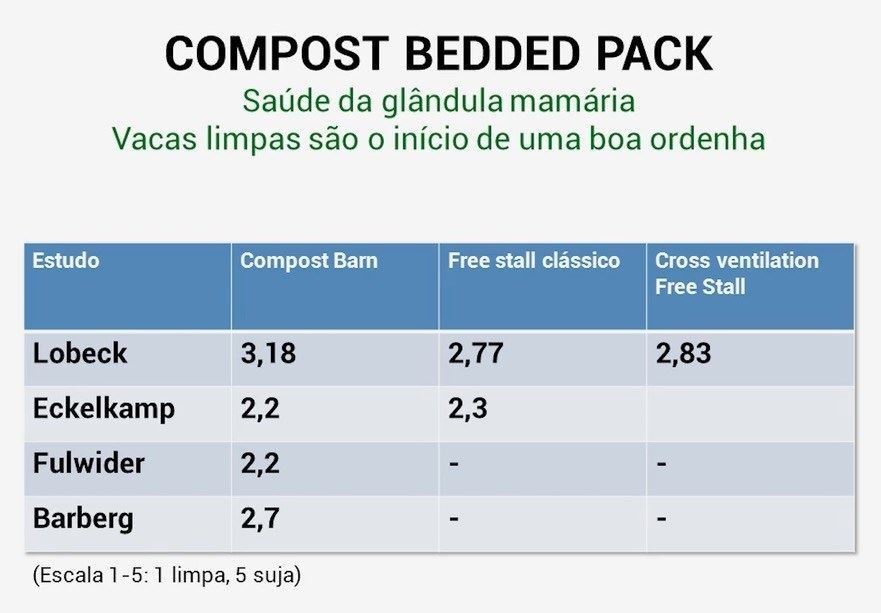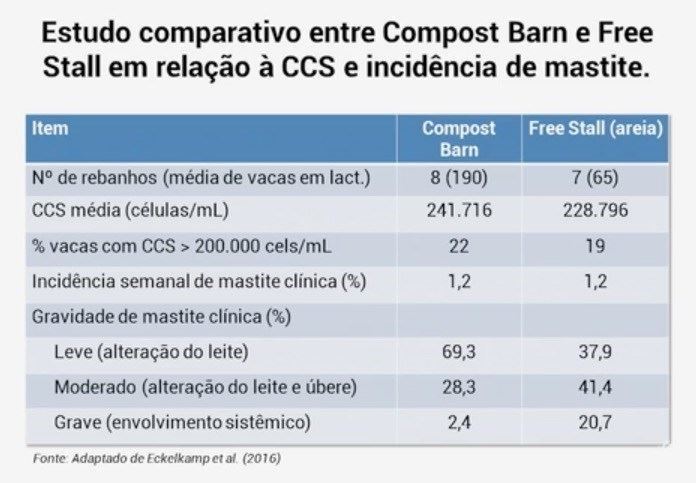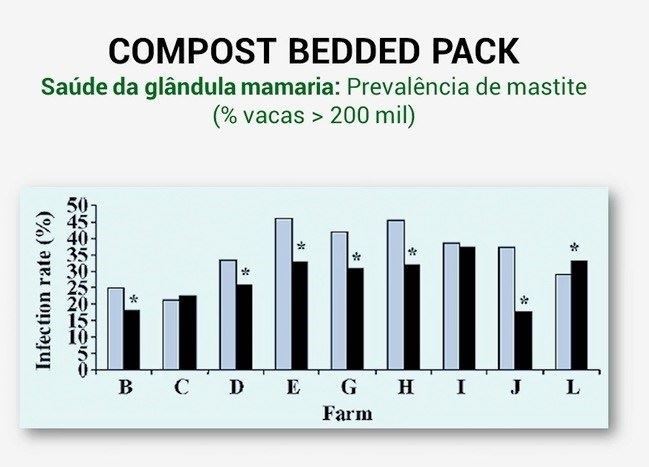Compost barn: what it is and what its advantages are
The compost barn system began in the mid-1980s in the USA, more specifically in Virginia. The system was developed by producers and derived from the bedded pack system where it serves as a physical barrier between the manure and the cow.
The method reconciles production and the environment, as it is based on the action of microorganisms that use organic matter as a substrate and aims to reduce implementation and maintenance costs, improve production and health indexes of livestock and enable the correct use of organic waste ( feces and urine) from dairy activities.
Compost barn at Sítio Tapir (Source: MilkPoint)
The composting process consists of producing carbon dioxide (CO2), water and heat from the aerobic fermentation of organic matter. In the compost barn, cow feces and urine provide the essential nutrients (carbon, nitrogen, water and microorganisms) necessary for the composting process to occur. The oxygen used in composting comes from the daily aeration that must be carried out in the bed.
The success of the composting process depends on maintaining adequate levels of oxygen, water, temperature, amount of organic matter and activity of microorganisms, which produce sufficient heat to dry the material and reduce the population of pathogenic microorganisms. For this process to occur, the temperature must vary from 54 to 65OC, 30 cm from the bed surface.
Bed management
For composting to work properly, oxygen must be introduced to the litter. This is done by turning the bed, either using a scarifier or a rotary hoe attached to a tractor. Today, on the national market, there are also scarifiers coupled to rotary hoes.
It is very important that during scarification a depth of 25 to 30 centimeters is reached, and can reach up to 40 centimeters. It is worth mentioning that the soil below the bed must not be touched by the scarifier, because any mixture of soil and litter can create adobe and, as a result, the bed will be compacted.
It is also necessary that the scarifier is wide enough to cover the tractor's wheels. This way, it is guaranteed that the bed will always be moving behind the wheel and will not be compacting the area covered by the tractor wheel.
It is also interesting to use small tractors and, preferably, tractors.
Bed in compost barn (Source: NRCS)
Benefits
This system is gaining more and more space in the USA and also in Brazil, precisely because it brings a series of advantages. In the latest Top 100 survey carried out by MilkPoint, when asked about the housing used for lactating cows, the properties participating in this edition are supporters – for the most part – of the confined system, predominantly the free stall, in 46% of the properties. Next, the composite barn appears, representing 22%.
A study carried out in the United States evaluated this system of facilities in terms of animal comfort and longevity. Twelve dairy farms that adopted the compost barn system were studied with the main objective of providing comfort to the animal, increasing the longevity of the cows, and improving the ease of management that is associated with this system. The results of this study carried out by the University of Minnesota indicated some notable changes in relation to comfort and the impact on productivity and longevity:
• Reduction of hull problems, because compared to free-stall systems, in the compost barn the cows have more space, which allows greater freedom of movement both to move around and to lie down. Furthermore, even when standing, the cows remain on a softer surface than concrete. A study carried out in the state of Minnesota demonstrated a percentage of 7.8% of cows with hoof problems on properties with compost barn, compared to 19.6 to 27.8% on free-stall properties.
• With the improvement in hoof health, the cows showed greater ease of heat manifestation, improving the heat detection rate by keepers. In the same study in Minnesota, heat detection rates increased from 36.9% to 41.4% and conception rates increased from 13.2% to 16.5% when cows were moved from free-stall to compost barn.
• Improving milk quality, with a reduction in SCC and a lower incidence of mastitis. This fact can be explained both by the reduction in environmental mastitis due to the reduction of the microbial load in the bed, improvement in the hygiene condition of the cows before milking, and by the improvement in the cows' immune system promoted by the more comfortable environment.
Some producers also noted that the low initial investment cost for the construction of a compost barn, when compared to the costs of building a free-stall barn. Another interesting fact provided by the compost barn is the reduction in the accumulation and disposal of waste, which includes costs for storage, necessary space and labor, compared to free-stall systems.
Is it possible to guarantee the good health of the mammary gland in this system?
When compost barn was introduced in Brazil, many people doubted that it would be possible to have as good mammary gland health in this system as in free stall. However, several American studies have shown that the two systems are similar in terms of the number of somatic cells and incidence of mastitis within the herd.
Check the table below for a comparison of the cleaning score between four jobs:
In the first work, it was noted that the compost barn had slightly dirtier cows than in the sand free stall and the sand free stall with cross ventilation. In the second study, there was no statistical difference. In the other two studies, the cleaning score was very close to that reported in free sand stalls.
In this way, it can be said that the cows in a well-managed compost barn are as clean as in a good free stall.
The work below compared cows housed in a compost barn with cows housed in a free stall with sand beds:
The work showed that any of the herds can have somatic cells at extremely low levels. Furthermore, the incidence of mastitis was the same in both systems, demonstrating that compost barn can be as good for mammary gland health as a well-managed free stall.
The work below compared free stall and tie stall farms that transitioned to compost barn:
The graph shows that several farms had a significant improvement in somatic cells and there was only one farm where the herd's somatic cell count increased.
Still in the same work, we have the graph below:
The graph shows the prevalence of mastitis, that is, cows with more than 200,000 somatic cells per ml. On the vast majority of farms, there was a decrease in the prevalence of mastitis.
Farms in Brazil that introduced the compost barn system saw a decrease in the incidence of mastitis and herd SCC. This happens mainly because the main advantage of compost barn is heat, which is what makes the litter dry. Dry bedding ensures clean cows and, in turn, the start of good milking.
Despite this, all preparatory milking management and all cow drying care are still necessary in the compost barn.
Frequent errors in managing compost barn
1- Attempt to save energy
Depriving yourself of turning on fans during the day due to the cost will cause damage. Choosing not to leave the fans on throughout the day, only turning them on during the hottest periods, will make the bed more humid, increasing the occurrence of mastitis. This happens because when the humidity in the bed increases, the bed material adheres to the skin and the hole in the teat, making it easier for bacteria to enter through the teat channel.
The main bacteria that have been observed causing mastitis in compost barn systems are: environmental streptococci, coliforms – including Klebsiella, among other bacteria. Generally, clinical mastitis occurring in this scenario is grade 2 or 3, which causes swelling of the udder, often accompanied by systemic symptoms, and may even lead to the animal's death.
Therefore, in this context, the fan stops being a cost and becomes an investment, as it will keep the bed dry, preventing diseases and improving the cows' environment (increasing milk production).
2- Feeding the cows inside the compound
When cows feed inside the bed it is very difficult to keep this space dry. Cows often end up lying down next to the trough and coming into contact with moisture again, increasing the likelihood of intramammary infections.
3- Frequency of turning the bed
Some producers, due to lack of a tractor or some management within the farm, turn the bed once a day or once every two days. As a result, the composting process is compromised, and the moisture content of the litter increases – even with the use of fans. Therefore, it is advisable to turn the bed at least twice a day, thus ensuring a homogeneous composting process, facilitating the loss of moisture into the environment and making the bed drier. Remembering that, when turning the bed, it is important to reach the deepest layers of the compost, for example: if the bed is 50cm high, it must be turned 35 to 40cm deep.
4- Installation failures
For example: low ceilings, few fans (not covering the entire bed area), incorrect inclination of the fans (losing wind efficiency), among others. In environments where these failures occur, system performance will be harmed.
Sources consulted:
Compost barn: is it possible to guarantee good mammary gland health? (https://www.educapoint.com.br/blog/pecuaria-leite/compost-saude-glandula-mamaria/)
Bed management at the Compost Barn determines the cleanliness of the cows (https://www.educapoint.com.br/blog/pecuaria-leite/manejo-compost/)
4 common mistakes when managing compost barn (https://www.educapoint.com.br/blog/pecuaria-leite/erros-frequentes-manejo-compost-barn/)
Compost Barn: An alternative to confinement of dairy cows (https://www.milkpoint.com.br/colunas/marco-veiga-dos-santos/compost-barn-uma-alternativa-para-o-confinamento-de- dairy-cows-204771n.aspx)
Compost Barn System: characterization of milk quality and mastitis, reproductive, animal welfare, compost and economic parameters in tropical conditions (https://www.embrapa.br/busca-de-projetos/-/projeto/209863/ compost-barn-system-characterization-of-milk-quality-parameters-and-reproductive-mastitis-animal-welfare-of-compost-and-economic-in-tropical-conditions)









